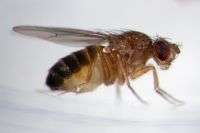The how and why of freezing the common fruit fly

Using a microscope the size of a football field, researchers from The University of Western Ontario are studying why some insects can survive freezing, while others cannot.
Why is this important? Because the common fruit fly (Drosophila melanogaster) is one of the bugs that cannot survive freezing and the little creature just so happens to share much of the same genetic makeup as humans, therefore finding a way to freeze them for research purposes is a top priority for geneticists the world over (about 75 per cent of known human disease genes have a recognizable match in the genetic code of fruit flies).
And why the large microscope?
"It's the only one in the world that's set up for this kind of imaging on insects," says lead researcher Brent Sinclair of his team's use of the Advanced Photon Source (APS), located near Chicago, Illinois. The APS generates high-energy x-rays that allow Sinclair and his collaborators to film the formation and spread of ice in real time as the maggots freeze.
An assistant professor in Western's Department of Biology, Sinclair explains that the physical processes of ice formation seem to be consistent among species that do and don't survive freezing. However, it seems that the insects that survive freezing have some control over the process of ice formation. They freeze at consistently higher temperatures than those that don't.
Sinclair says this implies that the main adaptations required to survive freezing are at the cellular or biochemical level, rather than because of fundamental structural differences.
"We're comparing Chymomyza amoena, an insect native to Ontario that survives freezing, with Drosophila melanogaster, because they're very close relatives," says Sinclair. "The idea is to find the magic bullet which allows some bugs to survive freezing and some don't. That's the goal here."
More information: Read the published research at www.plosone.org/article/info:doi%2F10.1371%2Fjournal.pone.0008259
Provided by University of Western Ontario















